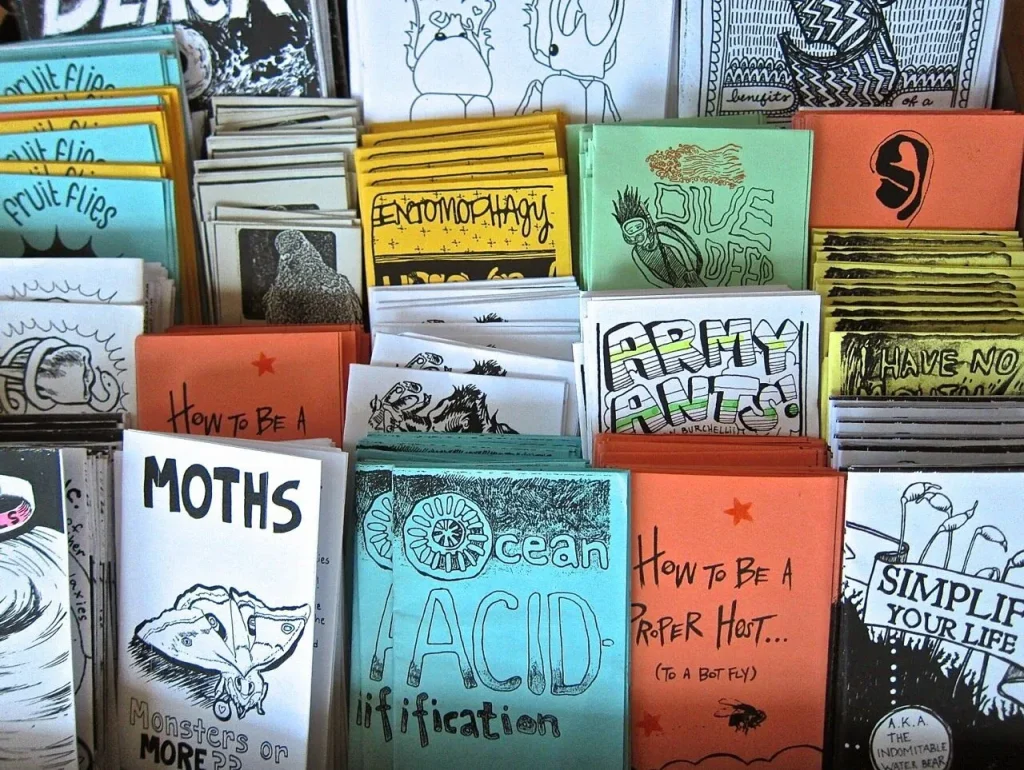Is Print Really Dead? The Unexpected Return of Zines

Is print really dead? The unexpected return of zines is a story about how a supposedly outdated medium is thriving in the digital age. Zines—small, self-published magazines—are making a bold comeback, driven by a new generation that craves authenticity, creativity, and community. This article explores why zines are back, what makes them special, and how they’re shaping culture in 2025 and beyond.
Introduction: Is Print Really Dead?
For years, headlines declared the death of print. Newspapers shrank, magazines folded, and everything seemed to go digital. Yet, in 2025, print is not only alive—it’s being reinvented by zine culture. Zines are proof that people still crave tangible, personal, and creative experiences that digital media can’t fully replace. From punk fanzines to Gen-Z collectives, the print revival is real and growing.

What Are Zines? A Brief History
- Definition: Zines (short for magazines or fanzines) are small-circulation, self-published booklets, often handmade and distributed by their creators.
- Origins: Zines date back to the 1930s, when science fiction fans used them to share ideas outside mainstream publishing. The form exploded in the punk and riot grrrl scenes of the 1970s-1990s, giving voice to subcultures and activists.
- Modern Zines: Today’s zines cover everything from art, politics, and music to personal stories and niche hobbies. They’re still fiercely independent and often anti-mainstream.
Why Are Zines Making a Comeback?
Is Print Really Dead? Why Zines Are Back
1. Digital Fatigue
People are overwhelmed by endless scrolling, notifications, and algorithm-driven content. Zines offer a tactile, mindful break—a way to slow down and engage deeply with content.
2. Authenticity and Connection
Zines are raw and personal. There’s no corporate filter, no ads, and no algorithms. Readers connect directly with the creator’s voice and vision.
3. Creative Freedom
Zines are a playground for creativity. There are no rules—anyone can experiment with design, art, poetry, or politics. This freedom attracts artists, writers, and activists.
4. Community and Belonging
Zines build real communities, both locally and globally. They give marginalized voices a platform and help people find others who share their passions.
5. Nostalgia and Permanence
In a world of disappearing stories and digital ephemera, zines are physical objects you can hold, collect, and revisit. They feel permanent and meaningful.
6. DIY Empowerment
Making a zine is empowering. It’s about taking control of your message and sharing it on your terms—no publisher needed.

Key Features of Modern Zine Culture
- DIY Ethos: Most zines are handmade, using collage, hand lettering, and photocopying.
- Small Circulation: Zines are often distributed in small batches—sometimes just a few dozen copies.
- Niche Topics: From queer rights to underground music, zines thrive on topics ignored by mainstream media.
- Personal Expression: Zines are often autobiographical or deeply personal, reflecting the creator’s unique perspective.
- Community Events: Zine fests and fairs are popular, where creators trade, sell, and discuss their work.
- Hybrid Forms: Many zines now blend print and digital, with creators sharing PDFs or interactive versions online.
Zines vs Digital Media: A Comparison Table
| Feature | Zines (Print) | Digital Media |
|---|---|---|
| Accessibility | Local, small batch, in-person | Global, instant, online |
| Cost | Low (DIY production) | Varies (hosting, ads, etc.) |
| Creative Control | 100% creator-driven | Platform and algorithm limits |
| Permanence | Physical, collectible | Often fleeting or deleted |
| Sharing | Hand-to-hand, mail, fests | Social media, email, links |
| Community | Intimate, niche, offline/online | Broad, sometimes impersonal |
| Feedback | Direct, personal | Comments, likes, algorithms |
| Distraction Level | Low | High (notifications, ads) |
How to Make Your Own Zine
Is Print Really Dead? DIY Zine Creation
1. Choose Your Theme
Pick a topic you care about—music, art, politics, food, comics, or your own story.
2. Plan Your Content
Decide what to include: essays, poems, drawings, photos, reviews, interviews, or collages.
3. Design Your Pages
Use paper, scissors, glue, pens, and markers. Or design digitally and print. Embrace imperfection—zines are about personality, not polish.
4. Assemble and Bind
Fold your pages, staple or sew the spine, or use creative binding. Each zine is unique.
5. Make Copies
Photocopy at home, at a print shop, or use a library. Digital zines can be shared as PDFs.

6. Share and Distribute
Give your zine to friends, leave it in cafes, sell at zine fests, or upload online. Build your own audience.
The Cultural Impact and Diversity of Modern Zines
Is Print Really Dead? Zines as Tools for Change
Zines are more than just creative booklets—they’re powerful instruments for social commentary, activism, and cultural preservation.
Zines as Voices for the Marginalized
- Amplifying unheard voices: Zines have long been a platform for LGBTQ+, feminist, and minority communities to share stories ignored by mainstream media.
- Grassroots activism: During protests or social movements, zines quickly spread information, safety tips, and solidarity messages.
- Preserving subcultures: From punk in the UK to hip-hop in Brazil, zines document underground scenes that might otherwise be lost.
“Zines let us tell our own stories, in our own words, without waiting for permission.”
— Zine creator, São Paulo
Zines in Education and Libraries
- Teaching tool: Teachers use zines to encourage student creativity, literacy, and self-expression.
- Library collections: Many libraries now archive zines as cultural artifacts, recognizing their role in documenting local history and social change.
Zines and the Art World
- Gallery exhibitions: Zines are featured in art shows, blurring the line between publishing and fine art.
- Artist collaborations: Painters, illustrators, and poets use zines to experiment and share limited-edition works.
The Global Spread: Zines Around the World
Is Print Really Dead? Zines from Lagos to Latin America
Africa
- Lagos punk zines: Chronicling Nigeria’s underground music and art scenes.
- Activist zines: Used to discuss social justice, gender rights, and youth culture.
South America
- Brazilian art zines: Vibrant, collage-heavy zines document street art, music, and politics.
- Argentina’s feminist collectives: Zines empower women and LGBTQ+ communities, often distributed at protests and cultural events.
Asia
- Japanese doujinshi: Self-published manga zines are a massive subculture, with thousands of creators and fans.
- Philippines indie zines: Focus on poetry, comics, and social issues.
North America & Europe
- Queer and feminist zines: Continue to thrive, especially in university towns and urban centers.
- Environmental zines: Focus on climate action, sustainable living, and local activism.
The Business of Zines: From Hobby to Hustle
Is Print Really Dead? Zines as Creative Enterprises
Monetizing Zines
- Selling at fairs and online: Creators use Etsy, Big Cartel, and Instagram to reach global audiences.
- Crowdfunding: Platforms like Kickstarter help fund ambitious zine projects.
- Collaborative anthologies: Groups pool resources to publish themed collections, splitting costs and profits.
Zines and Branding
- Indie brands: Use zines as marketing tools, sharing their story and values in a tangible format.
- Musicians and artists: Release zines alongside albums or exhibitions to deepen fan engagement.
Visual: Zine Production Workflow
| Step | Description | Tools Needed |
|---|---|---|
| Ideation | Brainstorm topics, themes, and contributors | Notebook, mood board |
| Content | Write articles, draw, take photos, create art | Pens, paper, camera, laptop |
| Layout | Arrange pages, collage, design | Scissors, glue, software |
| Printing | Photocopy, print at home, or use a print shop | Printer, copier, paper |
| Binding | Staple, sew, or fold pages | Stapler, needle, thread |
| Distribution | Sell, swap, mail, or upload digital versions | Envelopes, website, email |
Zines and Digital Synergy
Is Print Really Dead? The Hybrid Zine Movement
- Digital-first zines: Some creators design zines for screens, then print limited runs for collectors.
- Online zine libraries: Free and paid platforms host thousands of zines as PDFs or flipbooks.
- Social media: Used to promote, preview, and connect with readers worldwide.
Case Studies: Zine Stories from Around the World
Case Study 1: Gen-Z Art Collective
Two teenagers in California launched a zine during lockdown, building a supportive online and print community for young artists and activists. Their zine, “antifragile,” became a platform for marginalized voices and creative collaboration.
Case Study 2: Punk Fanzines in Lagos
A group of music fans in Lagos revived the tradition of punk zines, using them to document local bands, share gig reviews, and connect the underground scene.
Case Study 3: Feminist Zines
Inspired by the riot grrrl movement, a collective in London publishes zines on intersectional feminism, using handmade art and essays to spark dialogue and activism.
Case Study 4: Mental Health Zines
A mental health advocate in Toronto creates zines with personal stories and coping tips, distributing them at clinics and online to support others.
Case Study 5: Political Activism
During protests, activists in Hong Kong used zines to share news, art, and safety tips, bypassing censorship and building solidarity.
Case Study 6: Food and Recipe Zines
A chef in New York publishes a quarterly zine with recipes, food stories, and illustrations, building a loyal following among local foodies.
Case Study 7: Comic Book Zines
Young artists in Tokyo create comic zines, mixing manga styles with personal stories and distributing them at comic markets.
Case Study 8: Digital-Print Hybrid Zines
A designer in Berlin creates zines that exist both as limited-edition print objects and interactive online flipbooks, blending analog and digital creativity.
Case Study 9: The Climate Zine Collective (Chile)
A group of young activists in Santiago launched a bilingual zine about climate change, blending art, interviews, and science. It became a resource for schools and NGOs across South America.
Case Study 10: The Afro-Futurist Zine (Nigeria)
Artists in Lagos created a zine exploring African science fiction, mixing comics, essays, and photography. The zine inspired workshops and a local festival.
Case Study 11: The Pandemic Diary Zine (Global)
During COVID-19, people worldwide contributed diary entries, poems, and drawings to a collaborative zine, capturing a historic moment from many perspectives.
Case Study 12: The Food Story Zine (Mexico)
Chefs and food writers in Mexico City published a zine about street food culture, sharing recipes, interviews, and illustrations. It became a collector’s item and inspired pop-up events.

The Future of Print: Trends to Watch
H2: Is Print Really Dead? What’s Next for Zines
- Eco-friendly production: More zines use recycled paper and plant-based inks.
- Augmented reality: Some print zines include QR codes linking to videos or playlists.
- Global collaboration: Creators from different countries co-author zines via online platforms.
- Archival projects: Museums and universities increasingly collect and digitize zines for research.
Inspiring Quotes
“In a world of endless feeds, a zine is a pause—a moment to connect, create, and reflect.”
— Zine Fest Organizer, Buenos Aires
“Print isn’t dead. It’s just getting started, one page at a time.”
— DIY Publisher, Lagos
Pros and Cons Table
| Pros of Zines | Cons of Zines |
|---|---|
| Creative freedom, no gatekeepers | Small reach compared to online |
| Tangible, collectible, memorable | Can be costly/time-consuming to make |
| Builds real communities | Limited distribution |
| Empowers marginalized voices | Not easily searchable |
| Low distraction, high engagement | Can be lost or damaged |
| DIY skills and learning | Not always profitable |

Tips for Zine Creators and Readers
- Start small: Your first zine doesn’t need to be perfect. Focus on expression, not perfection.
- Embrace imperfection: Handmade is part of the charm.
- Find your community: Attend zine fests, join online groups, or swap with friends.
- Mix media: Combine text, art, photos, and collage for a unique look.
- Share widely: Leave zines in public places, mail them, or post digital versions.
- Support others: Buy, trade, and promote zines from fellow creators.
- Document your process: Share your journey to inspire others.
- Stay true to your voice: Zines are about authenticity and passion, not trends.
Frequently Asked Questions (FAQ)
1. What is a zine?
A zine is a small, self-published magazine or booklet, often handmade and focused on niche or personal topics.
2. Why are zines popular again?
People crave authenticity, creative freedom, and real connection—zines offer all three in a world of digital overload.
3. How do I make a zine?
Plan your theme, create content, design pages, assemble and bind, then photocopy or print. Share in person or online.
4. Are zines only for artists?
No, anyone can make a zine—writers, activists, cooks, musicians, or anyone with a story to tell.
5. Can I make a digital zine?
Yes! Many creators share zines as PDFs or interactive flipbooks online.
6. Where can I find zines?
At zine fests, independent bookstores, libraries, online shops like Etsy, and digital platforms.
7. Are zines expensive to make?
They can be very cheap—just paper, pens, and access to a copier. Some invest in higher-quality materials for limited editions.
8. What topics do zines cover?
Anything—music, art, politics, mental health, food, comics, personal stories, and more.
9. How do zines build community?
By connecting people with shared interests, giving marginalized voices a platform, and encouraging collaboration.
10. Is print really dead?
No—zines prove that print is alive, evolving, and more relevant than ever for those who value creativity and connection.
Conclusion
Is print really dead? The unexpected return of zines shows that print is not only surviving but thriving in new, creative ways. Zines offer a powerful antidote to digital fatigue, connecting people through tangible, personal, and authentic storytelling. Whether you’re a creator or a reader, zines invite you to slow down, engage deeply, and be part of a living, breathing culture that values individuality and community over algorithms and ads. The print revolution is here—one handmade page at a time.




